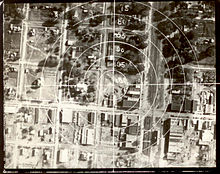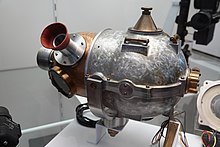
Back Bombesigte Danish Visor de bombardero Spanish Viseur de bombardement French 爆撃照準器 Japanese Celownik bombowy Polish Бомбовый прицел Russian Бомбовий приціл Ukrainian


A bombsight is a device used by military aircraft to drop bombs accurately. Bombsights, a feature of combat aircraft since World War I, were first found on purpose-designed bomber aircraft and then moved to fighter-bombers and modern tactical aircraft as those aircraft took up the brunt of the bombing role.
A bombsight has to estimate the path the bomb will take after release from the aircraft. The two primary forces during its fall are gravity and air drag, which make the path of the bomb through the air roughly parabolic. There are additional factors such as changes in air density and wind that may be considered, but they are concerns only for bombs that spend a significant portion of a minute falling through the air. Those effects can be minimized by reducing the fall time by low-level bombing or by increasing the speed of the bombs. Those effects are combined in the dive bomber.
However, low-level bombing also increases the danger to the bomber from ground-based defences, so accurate bombing from higher altitudes has always been desired. That has led to a series of increasingly sophisticated bombsight designs dedicated to high-altitude level bombing.
Bombsights were first used before World War I and have since gone through several major revisions. The earliest systems were iron sights, which were pre-set to an estimated fall angle. In some cases, they consisted of nothing more than a series of nails hammered into a convenient spar, lines drawn on the aircraft, or visual alignments of certain parts of the structure. They were replaced by the earliest custom-designed systems, normally iron sights that could be set based on the aircraft's airspeed and altitude. These early systems were replaced by the vector bombsights, which added the ability to measure and adjust for winds. Vector bombsights were useful for altitudes up to about 3,000 m and speeds up to about 300 km/h.
In the 1930s, mechanical computers with the performance needed to solve the equations of motion started to be incorporated into the new tachometric bombsights, the most famous of which is the Norden. Then, in World War II, tachometric bombsights were often combined with radar systems to allow accurate bombing through clouds or at night. When postwar studies demonstrated that bomb accuracy was roughly equal either optically or radar-guided, optical bombsights were generally removed and the role passed to dedicated radar bombsights. Finally, especially since the 1960s, fully computerized bombsights were introduced, which combined the bombing with long-range navigation and mapping.
Modern aircraft do not have a bombsight but use highly computerized systems that combine bombing, gunnery, missile fire and navigation into a single head-up display. The systems have the performance to calculate the bomb trajectory in real time, as the aircraft manoeuvres, and add the ability to adjust for weather, relative altitude, relative speeds for moving targets and climb or dive angle. That makes them useful both for level bombing, as in earlier generations, and tactical missions, which used to bomb by eye.